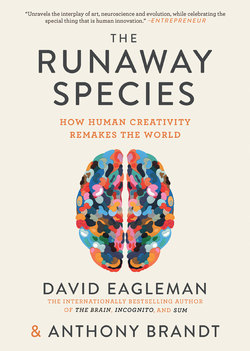Читать книгу The Runaway Species - David Eagleman - Страница 12
На сайте Литреса книга снята с продажи.
ОглавлениеCHAPTER 5
BLENDING
In blending, the brain combines two or more sources in novel ways. All over the world, representations of humans and animals have been blended to create mythical creatures. In ancient Greece, a man and a bull were combined to create a Minotaur. For the Egyptians, human plus lion equaled the Sphinx. In Africa, merging a woman and a fish produced a mami wata – a mermaid. What magic happened under the hood to generate these chimeras? A new merger of familiar concepts.
Brains have also blended animal with animal: the Greeks’ Pegasus was a horse with wings; the Southeast-Asian Gajasimha was half-elephant, half-lion; in English heraldry, the Allocamelus was part camel and part donkey. As with the mythology of old, our modern superheroes are often chimeric blends: Batman, Spiderman, Antman, Wolverine.
As in myth, so in science. Genetics professor Randy Lewis knew that spider silk had great commercial potential: it is many times stronger than steel.1 If only the silk could be produced in bulk, one could weave apparel such as ultra-light bulletproof vests. But it is difficult to farm spiders – when confined in large numbers, they turn into cannibals, eating each other for lunch. On top of that, harvesting silk from spiders is an arduous task: it took eighty-two people working with one million spiders several years to extract enough silk to weave forty-four square feet of cloth.2 So Lewis came up with an innovative idea: splice the DNA responsible for silk manufacturing into a goat. The result: Freckles the spider-goat. Freckles looks like a goat but she secretes spider silk in her milk. Lewis and his team milk her and then extract the strands of spider silk in the lab.3
Genetic engineering has opened up the frontier of real-life chimeras, producing not only spider-goats but also bacteria that make human insulin, fish and pigs that glow with the genes of jellyfish, and Ruppy the Puppy, the world’s first transgenic dog, who turns a fluorescent red under ultraviolet light thanks to a gene from a sea anemone.
Ruppy the Puppy in daylight and darkness
Our neural networks are adept at weaving together threads of knowledge from the natural world. Artist Joris Laarman took software that simulated the way the human skeleton develops and used it to build his “bone furniture.” Just as skeletons optimize the distribution of bone mass, Laarman’s furniture has more material where it needs to bear more weight.
In a similar vein, the Japanese engineer Eiji Nakatsu saw a blend with nature as the solution to a vexing problem. During the 1990s he was working on the bullet train to allow for faster travel times, but the existing design had an inherent drawback: the flat prow of its locomotive would create ear-shattering noise when moving at high speeds. An avid birdwatcher, Nakatsu knew that the tapered beak of the kingfisher enables it to dive into water with barely a ripple. Nakatsu’s solution for the bullet train: give the locomotive a beak. The locomotive’s bird-like nose reduces the train’s noise as it speeds along at two hundred miles an hour.
The brain often makes exotic combinations from things it’s seen before. For example, in this video installation by Chitra Ganesh and Simone Leigh, a woman’s gently breathing torso is blended with a lifeless pile of gravel.
Chitra Ganesh and Simone Leigh’s My dreams, my works must wait till after hell
At first blush, this combination of the living and non-living may only seem useful to generate art projects, but it also forms a solution to the problem of the world’s cracking buildings and roads. Half of the world’s constructions – everything from roads and bridges to high-rises – are made of concrete, a building material that is notoriously vulnerable to the elements and is difficult to mend. To fix this problem, chemists turned to the natural world. They added a particular strain of bacteria to the concrete, along with the bacteria’s favorite food. As long as the concrete is intact, the bacteria lie dormant. But if it cracks, the bacteria become active. Consuming the meal that has been waiting for them, they spawn and spread, excreting calcite that seals up the damage. Thanks to this unique blend of microorganisms and building materials, the concrete heals itself.4
In a similar vein, our neural networks are skilled at mixing our digital world with our analog one. Computers may surpass us in processing power, but some skills that are trivial for humans have proved arduous for our silicon avatars. One of these has traditionally been image recognition. Picking out a face is easy for a child, but it’s difficult for a computer.
Why? To a computer, a digital photograph is nothing more than a collection of pixels of different colors and intensities. The computer needs to learn higher-order patterns in order to identify the content of the photo, and it takes millions of examples to get there. This problem came to the fore in the early 2000s, as people around the world began to upload billions of images to the web. Google wanted a way to automatically label them, but, try as they might, they couldn’t come up with algorithms that worked.
